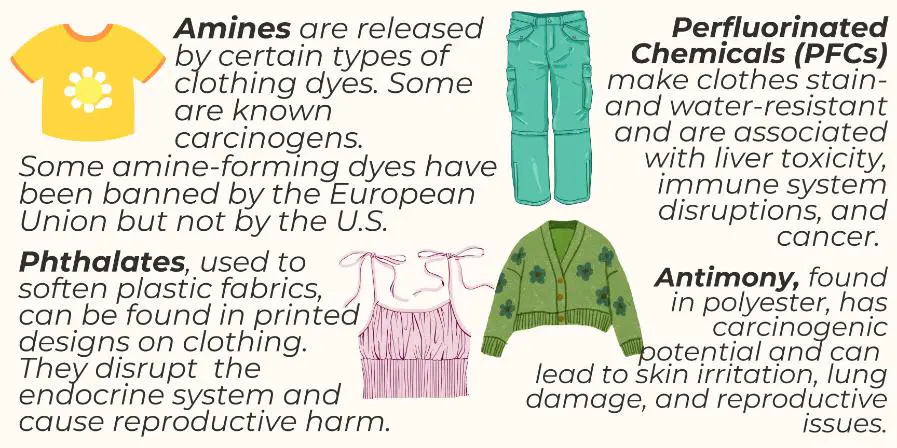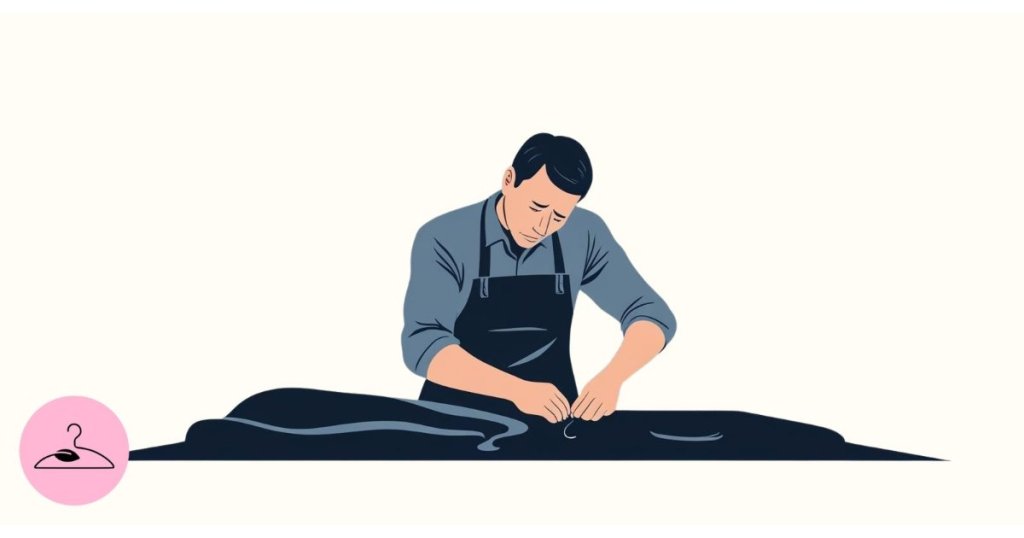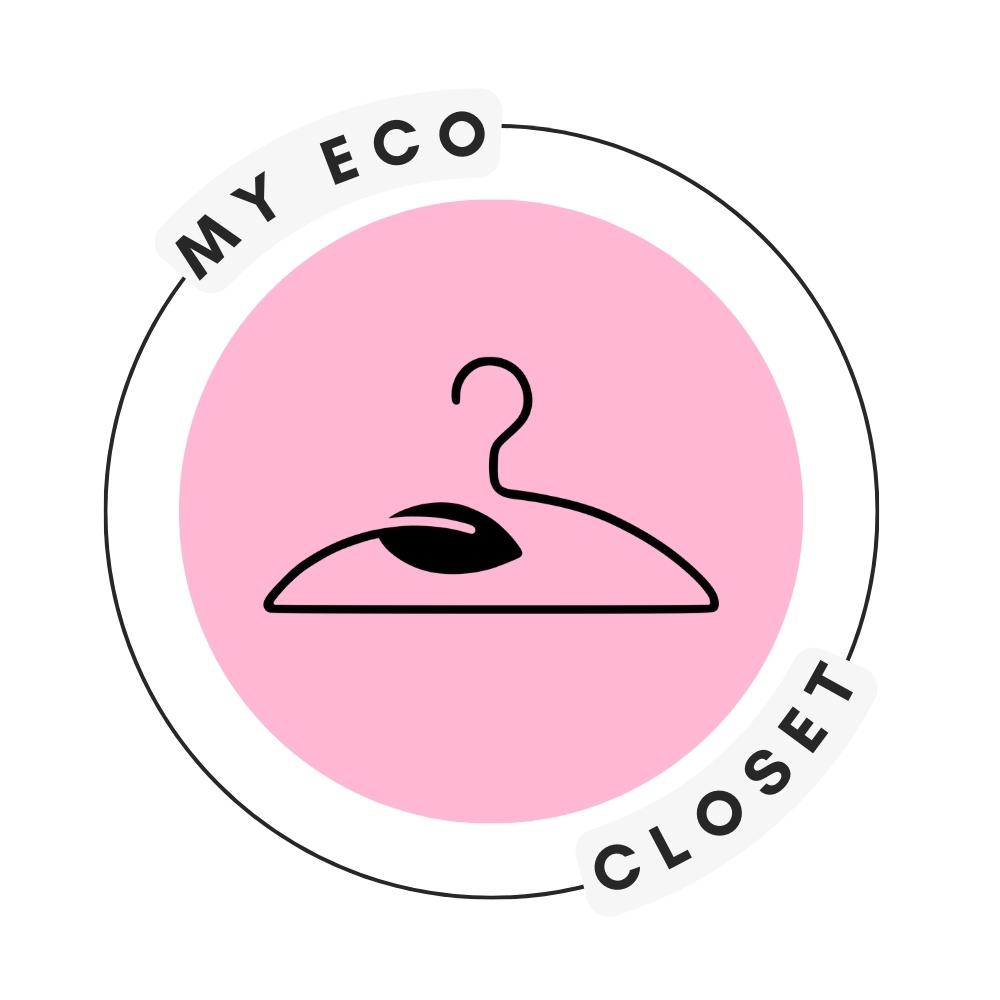In 2021, a consumer audit revealed alarming levels of lead in fast fashion products. Since then, consumers have scrambled to find ways to avoid lead exposure through their fashion purchases. So, how to remove lead from clothing, and is it even possible to do so? In this guide, we will explore key measures you can take to protect yourself from hazardous heavy metal content in your garments.

How to Remove Lead from Clothing?
As a surface-level measure, you can try washing toxins out of your clothes with laundry detergent that contains “surfactants.” These soap-on-steroids ingredients latch onto lead particles, as well as dirt, dragging them out when you rinse.
The most common surfactants found in detergents are sodium lauryl ether sulfate (SLES) and sodium dodecyl sulfate (SDS). Look for these ingredients in your detergent, and choose one labeled as heavy-duty or industrial-strength. These formulas are designed to tackle tough residues, including lead, more effectively.
For the best results:
- Use the longest wash cycle and the hottest water safe for the fabric.
- Add extra Borax to enhance the detergent’s cleaning power.
However, washing has its limitations. While surfactants like sodium lauryl sulfate (SLS) have been studied for their effectiveness in removing pollutants from fabrics (Journal of the American College of Toxicology), they primarily address surface-level contamination. Deeply embedded lead particles may remain even after multiple washes.
⚠️ In cases of severe contamination, disposal may be the safest option to prevent lead dust from spreading into your home.

Remove Lead From Clothing: What to Avoid
The biggest mistake that shoppers make is unboxing their fast fashion clothing freely in their living spaces. Unpacking your latest haul right on the living room floor may sound like a fun idea, however, it may spread lead into your house through household dust.
To avoid this health hazard, it’s best not to purchase fast fashion in the first place. However, if you do, take the following precautions:
- Open packages over a disposable trash bag to contain any potential contaminants.
- Seal and dispose of the trash bag carefully.
- Wash all clothing thoroughly before wearing.
- And again, avoid brands that don’t uphold safety standards
Your well-being is far more valuable than fleeting fashion trends — make choices that prioritize safety!

Preventative Measures: How to Remove Lead from Clothing
Fast fashion is cheap, but are those rock-bottom prices worth risking your health? According to recent exposés, clothes from Shein, AliExpress, Zaful, Lululemon, Old Navy, and more, are contaminated with alarming levels of lead. One study showed a jaw-dropping 1 out of 5 Shein samples containing high lead levels, which were way above the safety limits.
Unfortunately, fast fashion brands rarely conduct chemical safety tests on their products, and the responsibility to avoid heavy metals falls upon the consumer. So, as an informed fashionista, you must think twice before clicking ‘buy’ on those tempting fast fashion sites.
With that said, below, we have outlined some preventative measures for you to shop smart and safeguard your health:

1. Always Wash Your Clothes Before Wearing
New clothes, especially those from fast fashion brands, contain pathogens, chemical finishes, and heavy metals. Ulrika Nilsson, an expert of analytical chemistry, explains that washing them can remove some of these harmful substances left from manufacturing. With most detergents, washing your clothing before wearing guarantees to remove at least a layer of the aforementioned pathogens.
However, washing doesn’t get rid of all toxins. Some chemicals, like lead, flame retardants, and chromium, can stay in fabric even after multiple washes. Athletic wear, such as Lululemon leggings or Patagonia outerwear, often contains PFAS (“forever chemicals”), which the body cannot break down. These pervasive chemicals have even been identified in umbilical cord blood samples, as they are near impossible to detoxify from.
Similarly, formaldehyde resins in carcinogenic rayon never wash out from the fabric. Even after washing the rayon garment multiple times, the formaldehyde will linger within the fibers, harming your health with every wear. Why could this be concerning? Well, the International Agency for Research on Cancer (IARC), as well as the National Toxicology Program (NTP) label it as a human carcinogen, as it has the potential to cause leukemia and nasopharyngeal cancer.

2. Stay Away from Man-Made Fabrics
Unfortunately, no amount of washing or dry-cleaning can prevent synthetic chemicals from leaching into the skin. To safeguard your health, you must stay away from synthetic fabrics, including but not limited to:
- Polyester
- Nylon
- Rayon
- Acetate
- Acrylic
- Spandex
These fabrics are laden with synthetic dyes that almost always contain heavy metals. What speaks to this is textile waters that end up harming agriculture and fishing around clothing manufacturing sites, causing health issues in the locals who drink it. Just by observing the habitat of these sites, it becomes obvious that synthetic materials are toxic to our health, as they not only burden our bodies with lead but also azo dyes, solvents, and phthalates.
After all, these fabrics are essentially plastic. They release microplastics into the water during washing, polluting ecosystems and even entering the food chain. Most importantly, they trigger skin irritation, respiratory problems, and other health issues, accumulating in our tissues over time.

3. Beware of Bright Colors
Research shows that brightly colored pigments — especially yellow, green, and red— often contain high levels of lead. A review in Heritage Science highlights that lead-based pigments, such as lead chromate, have long been used to create vibrant shades like yellow and orange, making these garments potentially hazardous.
To reduce exposure, avoid brightly colored items like clothing, jewelry, bags, and accessories whenever possible.
This applies to special occasion wear as well. Even if you wear a bright-colored outfit just once, you could unknowingly spread lead dust onto your hair, shoes, skin, wardrobe, and even loved ones. This is known as the ‘take-home’ lead effect, which can harm both children and adults, causing fatigue, reproductive problems, lack of concentration, sleeplessness, insomnia, headaches, and more.

4. Avoid Clothes With Chemical Finishes
Wrinkle-free and sweat-free properties of clothing come with a price – our health. Chemical finishes sprayed on fabrics in order to make them more convenient or practical turns against us over time.
Beware of the following properties in textiles to avoid lead exposure from clothing:
- Oil repellent
- Flame retardant
- Anti-slip
- Anti-static
- Anti-microbial
- UV protection
- Insect resistant

5. Buy From Small-Scale Fashion Businesses
Small-scale, sustainable fashion brands employ natural and environmentally-friendly dyes, which are inherently biodegradable and contain no harmful chemicals. They are dedicated to providing safe products, devoid of carcinogenic and toxic compounds.
Ultimately, the biggest benefit of sustainable fashion lies in protecting the health of shoppers, as well as garment workers. Minimizing toxins, slow fashion brands employ organic textiles, such as cotton, hemp, linen, and wool, which are backed by GOTS, OEKO-TEX, and other certifications, ensuring their organic status.
Moreover, sustainable brands not only boast transparent supply chains but also ethical production practices. They feature unique, made-to-order, fair trade items, which are embedded in the appreciation of craftsmanship, worker safety, and natural production practices.

6. Opt for Natural Fabrics
Our skin is the biggest and only external organ in our body. Its porous texture makes it absorb, on average, around 64% of all the contamination we come in contact with. The 8000 different chemicals used in clothing production, in tandem with petroleum-based fabrics, create toxic synergistic effects – ultimately, harming our health.
Currently, prioritizing organic fabrics is the only way to steer clear of the dangerous lead and chemicals that have permeated the fashion world.
So, look for natural garments that are GOTS and OEKO-Tex 100 certified. The former ensures the presence of organic materials, while the latter indicates absence of toxic garment finishes and hazardous dyes. And embrace the following natural textiles:
- Bamboo
- Cotton
- Merino Wool
- Linen
- Wool
- Genuine Leather

A Simple Trick to Test Lead Exposure in Clothing
Once you unpack a piece of newly-bought clothing, soak it in clean water and squeeze the water into a separate container. Use a lead testing kit to detect the exposure in the water.
One of the most accessible lead testing kits on the market is Watersafe Test Kits, which show results in 10 minutes using just a dropper, a vial, and test strips. The test will show a positive result if lead levels exceed 15ppb (parts per billion).
Alternatively, you can opt for a Quick Test Kit for Lead, which can be applied to not only water but also dust, paint, food, and clothing. It marks the lead levels on the spectrum of 0 to 2.0 ppm (parts per million).

Interpreting the Results
Research shows that no amount of lead is safe to humans. Even low-level exposure to lead is associated with a reduction in school performance, various hearing disorders, and lower scores on standardized tests. What’s more, it is connected to hyperactive and violent behaviors.
While CDC set the international safe level of lead exposure at 100ppb in 1991, scholars insist on its inaccuracy. Considering the duration of blood lead elevation, as well as the age of the contaminated person, it’s impossible to determine the safe threshold for lead exposure that works for everyone.
Hence, if the lead test shows a positive result, you can assume that the garment is too dangerous to wear.

Health Concerns Associated With Lead Exposure in Clothes
Lead exposure occurs when coming in contact with the metal by touching, swallowing, breathing lead dust – through air, food, water, or clothing. The dust tends to sit on clothing, shoes, and jewelry and can be passed on to humans through skin contact.
Initially, lead poisoning is hard to detect – even healthy-looking people can suffer from it. It is only after long-term accumulation that lead exposure in clothes reveals itself through high blood pressure, reproductive, behavioral, and autoimmune issues.

Assessing Short-term Damage
As mentioned above, the human body can absorb the heavy metal via skin-contact, which, oftentimes, remains undetectable. In some people, however, the reaction triggers the so-called ‘lead contact dermatitis’ – rashes that appear as a result of chemical damage and inflammation of the skin.
In case of lead exposure, contact dermatitis can be either irritant or allergic, however, the former is more common. Keeping this in mind, observe the way your skin reacts to a particular piece of clothing – the irritant type of contact dermatitis can damage the top layer of the skin with redness, lesions, blisters, and cracks.
Assessing Long-term Damage
Through bioaccumulation, low levels of lead will penetrate and build up in your body over time. By this, they trigger autoimmune disorders, hypersensitivity, asthma, and eczema.
Apart from these, however, executive functions and attention are especially vulnerable to deterioration. Research associates lead exposure with behavioral changes, particularly, ADHD-type tendencies, hyperactivity, anxiety – even when it comes to low levels of exposure, such as 50ppb and below.

Lead Exposure Through Fast Fashion
Lead exposure in clothing is not another alarmist story. Although fast fashion brands like Shein claim to maintain “product safety”, their items are drenched in hazardous materials, such as lead, phthalates, and PFAS.
According to a 2021 investigation, 38 samples from AliExpress, Zaful, and Shein contained lead in clothing for children and adults. Selling low-priced items across more than 150 countries, these brands show no concern towards consumer safety.

A Case Study: High Levels of Lead Present in Urban Outfitters Apparel
According to a report by the Center for Environmental Health (CEH), clothing and accessories from Urban Outfitters contain dangerously high levels of lead and cadmium. The investigation found these heavy metals in the brand’s “Urban Renewal” collection, with lead levels reaching six digits.
While California prohibits accessories that have more than 60,000 parts per million (ppm) of lead, the necklace sold by Urban Outfitters had over 590,000 ppm of the metal, indicating that it is harmful to your health. This, once again, demonstrates that the industry is oblivious to safety regulations – therefore, consumers must avoid lead exposure by rejecting synthetic fabrics, cheap jewelry, and bright pigments.
Pervasive Chemicals in Fashion
Unfortunately, toxic chemicals are a common ingredient in clothing. Even activewear from Old Navy, LulaRoe, and Lululemon, contain “forever chemicals”, which are just one step behind lead exposure. However, beyond questioning, “how to remove lead from clothing?”, you should strive to eliminate all types of toxin exposure from your fashion purchases.
With that said, here are some of the chemicals to look out for in clothes:
- Chromium – used in textile manufacturing as a result of dyeing, causing skin irritation and chrome ulcers.
- PFAS – also known as “forever chemicals” – present in a variety of synthetic fabrics used in rain jackets, hiking pants, T-shirts, and sports bras, granting them water-resistant or stain-blocking properties.
- Flame Retardants – designed to stop clothes from burning, flame retardants accumulate in the bloodstream, triggering neurotoxicity, infertility, and cancer.
- Formaldehyde – found in synthetic garment finishes, this chemical causes allergic contact dermatitis and is used to eliminate mildew, boost anti-wrinkle properties, and make clothes sturdier.
- Antimony Trioxide – a catalyst used in polyester fabric production, antimony trioxide is a known carcinogen, which pollutes waste waters and local resources in fabric production facilities.

Affecting the Workers
Toxic chemicals in fashion not only damage our health but also pollute communities in the Global South, where our garments are made. Working in dangerous conditions, textile workers are forced to inhale cancer-causing chemicals – with no safety measures in place.
In fact, according to the International Labor Organization, one worker dies in every 30 seconds from chemical exposure in the fashion industry. This is an alarming statistic, because after all, we may be able to remove lead from clothing but not from the industry’s global supply chain.
For this reason, it’s crucial to stay away from plastic-derived fabrics, such as polyester, nylon, acrylic, as well as synthetic garment finishes that promise anti-wrinkling, stain-resistant, and water-resistant properties. This way, you will not only avoid major health risks but also vote with your dollar for a better fashion industry.

Frequently Asked Questions
Stock up on lead testing kits! The fastest way to detect lead in clothes is via D-lead test kits, which are sensitive to as little as 20mg of lead. The kits can identify lead on both clothing and its packaging. If the test is positive after you washed your clothes, you should treat them with a lead-removing detergent.
A good rule of thumb is to avoid fast fashion clothes with artificial (PU) leather, vibrant, man-made fabrics, and brightly-colored pigments, which are more likely to contain lead. If your clothes are made of artificial materials, it’s reasonable to assume that they carry traces of heavy metals in them.
Bright colors, especially yellow, green, and red, often contain the highest levels of lead due to the pigments used in their production. Wearing these garments can lead to spreading lead dust, affecting both the wearer and those around them.
Washing clothes can help reduce surface-level contaminants, including lead. However, certain toxins like “forever chemicals” (PFAS) or formaldehyde in fabrics may not wash out, making it difficult to fully remove all harmful substances, especially from synthetic garments.
Man-made fabrics such as polyester, nylon, rayon, and spandex are often treated with heavy metals and toxic dyes. These materials, commonly found in fast fashion, may harbor lead and other chemicals, posing health risks over time.
Chemical finishes like wrinkle-free or anti-microbial treatments are often applied to fabrics and can contain lead and other harmful chemicals. These finishes are commonly found in fast fashion and synthetic clothing, making them a significant source of toxic exposure through skin contact.

